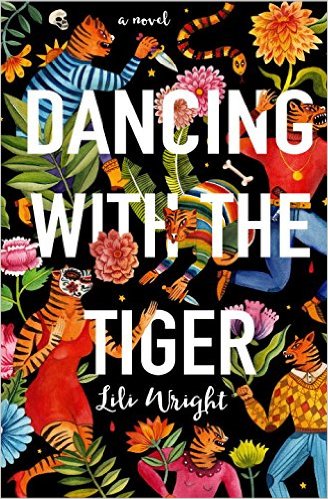Dancing With the Tiger by Lili Wright
 Lili Wright’s debut novel, DANCING WITH THE TIGER, is set in Mexico, a country the author knows well. Wright lived in Mexico twice, and she infuses this rollicking novel of art and addiction with her reporter’s eye for vivid detail.
Lili Wright’s debut novel, DANCING WITH THE TIGER, is set in Mexico, a country the author knows well. Wright lived in Mexico twice, and she infuses this rollicking novel of art and addiction with her reporter’s eye for vivid detail.
The story begins when a meth-addicted looter digs up what he believes is Montezuma’s funerary mask, a priceless artifact. A tense chase ensues as an eclectic cast of characters pursues the treasure for very different reasons. In addition to the meth-addicted looter, there is a masked tiger, an expat art collector, a dying drug lord, a lesbian housekeeper, and most importantly—Anna Ramsey, a 30-year-old American with a history of bad choices. Ramsey needs the mask to redeem her father—and save herself.
Here, Wright chats with The Big Thrill about her first foray into fiction.
Why did you choose to set your novel in Mexico?
I fell in love with Mexico years ago during a language immersion trip to Cuernavaca. At the time, I was a newspaper reporter in Salt Lake City and was taking a night class in Spanish. My professor, John Bahoric—I dedicated the novel to him—adored Mexico and, like the Piped Piper, seduced us into following him on his annual trip there. At the time, I spoke almost no Spanish and spent most of the trip asking my Mexican host family, “Mande?” (Slang, for What?) Like John, I adored Mexico. The country was so colorful, so different from staid New England where I grew up. Soon after, I won a year-long grant to return. I studied in Guadalajara and then landed in San Miguel de Allende. A decade later, I spent a sabbatical year in Oaxaca. Mexico always calls me back.
Much of the story revolves around masks. Why?
Even in our lowest moments, it is possible, often required, that we put on our game face and carry on. Friends and co-workers often haven’t a clue that we’re hurting. I remind myself of this when people are rude or distant. Who knows what’s going on in their lives? Maybe their dog died or they fought with their husband or they are worried about money.
That was one piece. Also, in my English classes, I teach essay writing. The founder of the modern essay, Michel de Montaigne, has this quote I adore: “We must remove the mask.” A good essay, or any creative writing, requires revelation, risk, digging below the surface. This isn’t easy. Most of us prefer to gloss over uncomfortable subjects and avoid conflict. In the opening paragraph of DANCING WITH THE TIGER, the looter notes: “Few people have courage or imagination to dig.” At the risk of sounding grandiose, I believe a willingness to dig, to expose, to talk openly about hard subjects, would help society solve many ills.
Also, more simply, I love masks. I’ve been collecting Mexican folk art for years—tin mirrors and black clay and Virgin of Guadalupe keepsakes. I bought my first coconut masks in Cuernavaca and have a small collection. For festivals and holidays, dancers still wear hand-carved masks—animals, old men, devils, tigers. Masks are whimsical and scary and really disconcerting, especially when topped off with a turkey-feather headdress or a fake gun. A mask transforms you into someone else, but it also allows you to transgress. You can hide and reveal yourself at the same time. When I started writing, I had this image of a woman seducing a man while wearing a mask, dancing for him, her toe pointed. The story evolved from that first impulse. Who is seducing whom? Who has the power?
So did you weave in true stories from your trips to Mexico?
Yes, many. The image of the swimming pool turning green from neglect came straight from our time in Oaxaca. Soledad’s memories of the ghost town, Real de Catorce, were written after I traveled there with a friend. The dreary hotel room with the wobbly fan? Well, I’ve spent way too many nights in hotels like that. On several trips to Mexico, I interviewed mask carvers and traveled by plane, bus, and truck, into the countryside to watch masked dances during Carnival. It was seriously hot and the dances took forever to start as the mayor blabbed on, urging us to buy iguana tacos. That is all true. Unlike the Tiger, however, I didn’t kill anyone. I did see a drunk man hauled off like a dead deer. That’s in the book.
I also did library research: about the repatriation of artifacts, drug dealers, smuggling, the Aztecs. The story includes nods to some of my favorite writers, from Denis Johnson to Daphne du Maurier. But Mexico is so dynamic, there’s no way to get it all in. I would need to write a sequel, or two.
Did you have a model when you wrote the novel?
Not really. I wrote a book I wanted to read: one that has elements of travel writing, a lively plot, sexual intrigue, plenty of surprise, and moments of revelation where readers would see a bit of themselves and the common ways we all struggle to connect.
*****
 Lili Wright is author of Dancing with the Tiger, a literary thriller set in Mexico, and the travel memoir, Learning to Float. Her essays and journalism have appeared in The New York Times, Newsweek, The Chicago Tribune, Down East, and many other publications. Wright worked as a newspaper reporter for 10 years before earning her MFA in nonfiction writing at Columbia University. She teaches English at DePauw University and in the MFA program at Butler University. On her website, you can read more about her debut novel and check out her collection of Mexican masks.
Lili Wright is author of Dancing with the Tiger, a literary thriller set in Mexico, and the travel memoir, Learning to Float. Her essays and journalism have appeared in The New York Times, Newsweek, The Chicago Tribune, Down East, and many other publications. Wright worked as a newspaper reporter for 10 years before earning her MFA in nonfiction writing at Columbia University. She teaches English at DePauw University and in the MFA program at Butler University. On her website, you can read more about her debut novel and check out her collection of Mexican masks.
- The Big Thrill Recommends: ORIGIN STORY by A.M. Adair - November 21, 2024
- Deadly Revenge by Patricia Bradley - November 21, 2024
- Unforgotten by Shelley Shepard Gray - November 21, 2024
